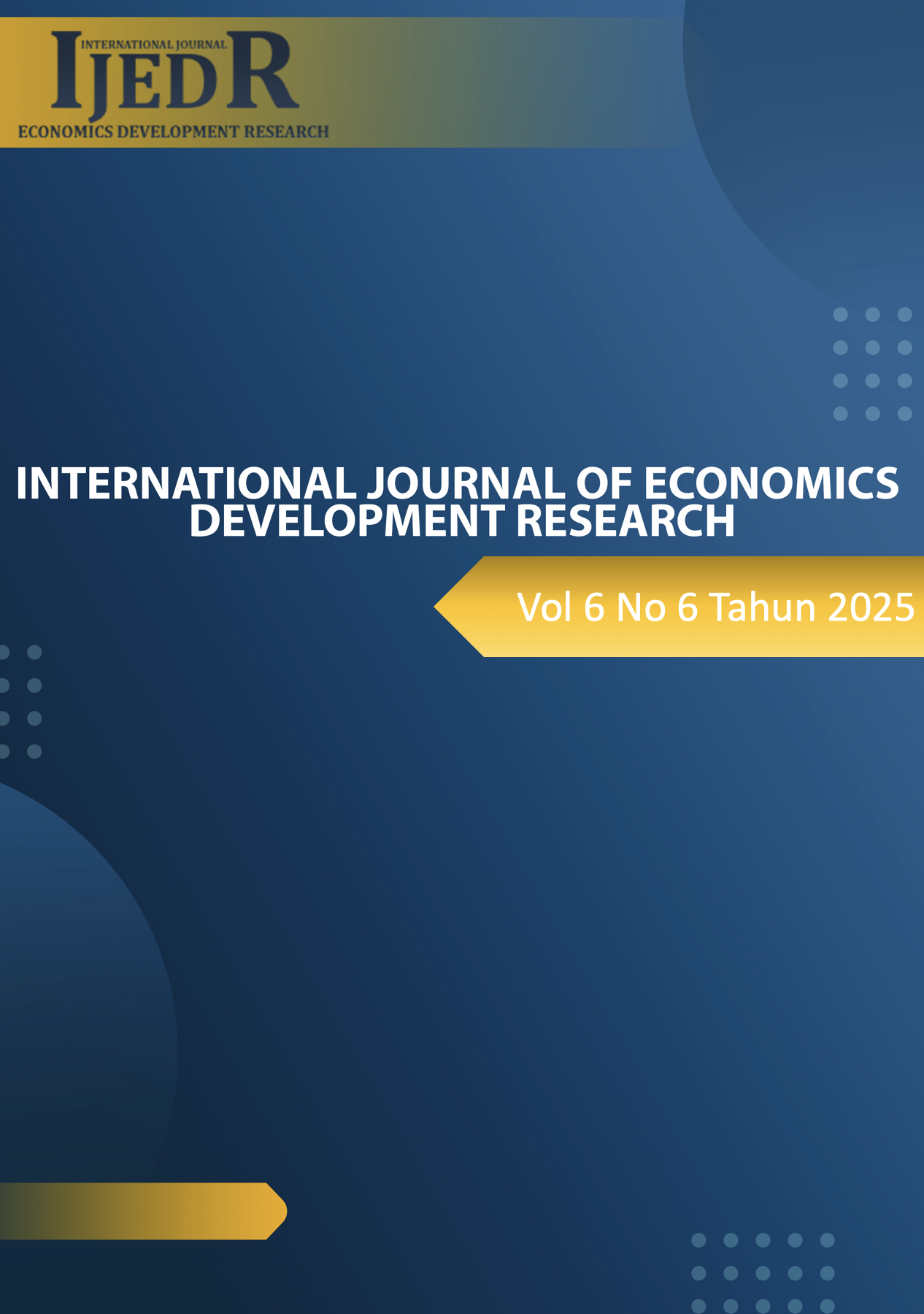Aligning Measures of Poverty: An Econometric Exploration of MPI-Income Mismatches in ASEAN (2019–2024)
DOI:
https://doi.org/10.37385/ijedr.v6i6.8651Keywords:
Multidimensional Poverty Index (MPI), Income Poverty, Mismatch, ASEAN, Panel Regression, Principal Component Analysis (PCA), Ridge Regression, Logit Model, Poverty Measurement, ProbitAbstract
This study investigates the mismatch between income poverty and multidimensional poverty (MPI) across six ASEAN countries: Indonesia, Cambodia, Laos, Philippines, Thailand, and Vietnam, over the 2019–2024 period. It explores the determinants of mismatch and the influence of specific deprivation indicators using a comprehensive set of econometric approaches. Combining descriptive trends with panel data analysis (OLS), PCA-based classification, ridge regression, and logit/probit models, the research draws from the Global MPI datasets and income poverty estimates to assess both cross-country and within-country dynamics. The findings reveal persistent mismatches: while income poverty shows consistent declines, MPI remains high in several countries due to sustained deprivations, particularly in living standards and education. PCA confirms the multidimensional structure of poverty, and binary choice models highlight the most significant contributors to mismatch. Countries like Cambodia face pronounced mismatches, while Indonesia and Vietnam exhibit better alignment between income and MPI. The study emphasizes the limitations of relying solely on income measures and advocates integrating MPI into national poverty strategies. By highlighting hidden deprivations, the research offers novel insights and actionable recommendations for improving the accuracy and inclusivity of poverty targeting mechanisms in the ASEAN region.References
Alkire, S., & Fang, Y. (2019). Dynamics of multidimensional poverty and uni-dimensional income poverty: An evidence of mismatch from China. Social Indicators Research, 142(1), 37–60. https://doi.org/10.1007/s11205-017-1870-1
Alkire, S., & Kanagaratnam, U. (2021). Global Multidimensional Poverty Index 2021: Unmasking disparities by ethnicity, caste and gender. Oxford Poverty and Human Development Initiative (OPHI).
Alkire, S., & Santos, M. E. (2010). Acute multidimensional poverty: A new index for developing countries. OPHI Working Paper No. 38. Oxford University.
Alkire, S., Roche, J. M., & Vaz, A. (2017). Changes over time in multidimensional poverty: Methodology and results for 34 countries. World Development. https://www.sciencedirect.com/science/article/pii/S0305750X17300256
Artha, R., & Dartanto, T. (2018). Multidimensional poverty in Indonesia: Trend, spatial disparity and multidimensional poverty reduction policy. Economics and Finance in Indonesia, 64(2), 89–114. https://doi.org/10.46963/efi.v64i2.85
Bourguignon, F., & Chakravarty, S. R. (2003). The measurement of multidimensional poverty. Journal of Economic Inequality, 1(1), 25–49. https://doi.org/10.1023/A:1023913831342
Dang, H. A., & Lanjouw, P. (2017). Welfare dynamics measurement: Two definitions of a vulnerability line and their empirical application. Review of Income and Wealth, 63(4), 633–660. https://doi.org/10.1111/roiw.12274
Davis, E. P., & Sanchez-Martinez, M. (2015). Economic theories of poverty. Joseph Rowntree Foundation. https://www.jrf.org.uk/report/economic-theories-poverty
Fang, Y., Wang, J., & Alkire, S. (2019). Identifying multidimensional poverty and mismatches with income poverty: Application of PCA approach in China. Journal of the Asia Pacific Economy, 24(1), 137–157. https://doi.org/10.1080/13547860.2018.1440314
Gujarati, D. N., & Porter, D. C. (2008). Basic econometrics (5th ed.). New York: McGraw-Hill Education.
Hair, J. F., Hult, G. T. M., Ringle, C. M., & Sarstedt, M. (2016). A Primer on Partial Least Squares Structural Equation Modeling (PLS-SEM) (2nd ed.). SAGE Publications. https://doi.org/10.4135/9781526470294
Hair, J. F., Black, W. C., Babin, B. J., & Anderson, R. E. (2010). Multivariate data analysis (7th ed.). Pearson.
Liu, W., Xu, J., & Liu, Z. (2023). Multidimensional poverty reduction in post-COVID recovery: Global strategies and local implementation. World Development, 162, 106092. https://doi.org/10.1016/j.worlddev.2023.106092
Poverty and Initiative. (2024). Global Multidimensional Poverty Index Report 2024. Oxford Poverty and Human Development Initiative (OPHI) and UNDP.
Sen, A. (1985). Commodities and capabilities. North-Holland.
Tenenhaus, M., Vinzi, V. E., Chatelin, Y. M., & Lauro, C. (2005). PLS path modeling. Computational Statistics & Data Analysis, 48(1), 159–205. https://doi.org/10.1016/j.csda.2004.03.005
UNDP (United Nations Development Programme). (2024). 2024 Global Multidimensional Poverty Index (MPI): Poverty amid conflict. New York: UNDP. https://hdr.undp.org/content/2024-global-multidimensional-poverty-index-mpi
UNDP & OPHI. (2023). Global Multidimensional Poverty Index Report 2023: Unstacking global poverty. United Nations Development Programme and Oxford University.
Wang, J., & Alkire, S. (2022). Using data-driven weights in multidimensional poverty measurement: Empirical insights from PCA and AHP. Social Indicators Research, 161, 257–278. https://doi.org/10.1007/s11205-021-02781-4
Wold, S., Sjöström, M., & Eriksson, L. (2001). PLS-regression: A basic tool of chemometrics. Chemometrics and Intelligent Laboratory Systems, 58(2), 109–130. https://doi.org/10.1016/S0169-7439(01)00155-1
Wold, H. (1985). Partial least squares. In Kotz, S. & Johnson, N. L. (Eds.), Encyclopedia of Statistical Sciences (Vol. 6, pp. 581–591). Wiley.
Wooldridge, J. M. (2013). Introductory econometrics: A modern approach (5th ed.). Mason, OH: South-Western Cengage Learning.
Zhang, H., Wang, J., & Zhu, Y. (2022). Mismatch between income poverty and multidimensional poverty: Evidence from rural China. China Economic Review, 73, 101803. https://doi.org/10.1016/j.chieco.2022.101803
Zhu, Y., Jia, M., & Zhou, H. (2021). Poverty eradication and SDGs: Evidence from developing countries. Journal of International Development, 33(5), 874–894. https://doi.org/10.1002/jid.3





